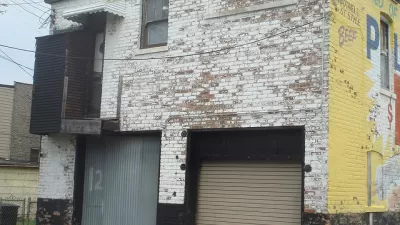New research assesses the land value of street space in 20 of the largest counties in the United States.

"During lockdowns, cities all over the world turned residential and commercial corridors into slow (or no) vehicle zones for pedestrians, cyclists, cafe seating, parklets and play," writes Laura Bliss in Bloomberg CityLab. Our ideas about what streets could be shifted radically in many places. Yet, before the pandemic, "people rarely questioned just how much space streets take up in the first place," says UCLA urban planning professor Adam Millard-Ball.
According to Millard-Ball's recent research into 20 U.S. counties, "streets took up 18% of the total land area in these counties, ranging from 14% in Middlesex County, Massachusetts (which contains the suburbs of Boston) to 30% in Kings County, New York (which is Brooklyn)." Millard-Ball also calculated the value of this space, "estimat[ing] that the residential streets in that area would be worth $959 billion if they were instead zoned for single-family homes, based on 2019 prices."
"Despite studies that show narrow streets are actually safer for users, large widths persist as required standards in local subdivision regulations." The programs created during the pandemic show that different uses are possible, and Millard-Ball argues the space could be better put to use as housing. "Cities could also allow owners to push property lines into streets to make way for front-yard ADUs or bigger, multi-family developments. And if that’s still too tricky, they could start by legalizing overnight parking for people who sleep in their cars and vans."
FULL STORY: MapLab: The High Cost of Wide Streets

Alabama: Trump Terminates Settlements for Black Communities Harmed By Raw Sewage
Trump deemed the landmark civil rights agreement “illegal DEI and environmental justice policy.”

Study: Maui’s Plan to Convert Vacation Rentals to Long-Term Housing Could Cause Nearly $1 Billion Economic Loss
The plan would reduce visitor accommodation by 25% resulting in 1,900 jobs lost.

Planetizen Federal Action Tracker
A weekly monitor of how Trump’s orders and actions are impacting planners and planning in America.

Wind Energy on the Rise Despite Federal Policy Reversal
The Trump administration is revoking federal support for renewable energy, but demand for new projects continues unabated.

Passengers Flock to Caltrain After Electrification
The new electric trains are running faster and more reliably, leading to strong ridership growth on the Bay Area rail system.

Texas Churches Rally Behind ‘Yes in God’s Back Yard’ Legislation
Religious leaders want the state to reduce zoning regulations to streamline leasing church-owned land to housing developers.
Urban Design for Planners 1: Software Tools
This six-course series explores essential urban design concepts using open source software and equips planners with the tools they need to participate fully in the urban design process.
Planning for Universal Design
Learn the tools for implementing Universal Design in planning regulations.
Caltrans
Smith Gee Studio
Institute for Housing and Urban Development Studies (IHS)
City of Grandview
Harvard GSD Executive Education
Toledo-Lucas County Plan Commissions
Salt Lake City
NYU Wagner Graduate School of Public Service




























